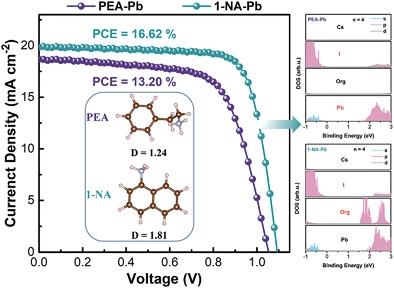当前位置:
X-MOL 学术
›
Adv. Funct. Mater.
›
论文详情
Our official English website, www.x-mol.net, welcomes your
feedback! (Note: you will need to create a separate account there.)
A Novel Multiple-Ring Aromatic Spacer Based 2D Ruddlesden–Popper CsPbI3 Solar Cell with Record Efficiency Beyond 16%
Advanced Functional Materials ( IF 18.5 ) Pub Date : 2022-06-22 , DOI: 10.1002/adfm.202205029 Huanhuan Yao 1 , Zhizai Li 1 , Chang Shi 2 , Youkui Xu 1 , Qian Wang 1 , ZhenHua Li 3 , Guoqiang Peng 1 , Yutian Lei 1 , Haoxu Wang 4 , Zhipeng Ci 1 , Zhiwen Jin 1
Advanced Functional Materials ( IF 18.5 ) Pub Date : 2022-06-22 , DOI: 10.1002/adfm.202205029 Huanhuan Yao 1 , Zhizai Li 1 , Chang Shi 2 , Youkui Xu 1 , Qian Wang 1 , ZhenHua Li 3 , Guoqiang Peng 1 , Yutian Lei 1 , Haoxu Wang 4 , Zhipeng Ci 1 , Zhiwen Jin 1
Affiliation

|
Two-dimensional (2D) Ruddlesden–Popper (RP) CsPbI3 perovskite possesses superior phase stability by introducing steric hindrance. However, due to the quantum and dielectric confinement effect, 2D structures usually exhibit large exciton binding energy, and the charge tunneling barrier across the organic interlayer is difficult to eliminate, resulting in poor charge transport and performance. Here, a multiple-ring aromatic ammonium, 1-naphthylamine (1-NA) spacer is developed for 2D RP CsPbI3 perovskite solar cell (PSC). Theoretical simulations and experimental characterizations demonstrate that the 2D RP CsPbI3 perovskite using 1-NA spacer with extended π-conjugation lengths reduces the exciton binding energy and facilitates the efficient separation of excitons. In addition, its cations have a significant contribution to the conduction band, which can reduce the bandgap, promote electronic coupling between organic and inorganic layers, and improve interlayer charge transport. Importantly, the strong π–π conjugation of 1-NA spacer can enhance intermolecular interactions and hydrogen bonding, and prepare high-quality films with preferred vertical orientation, resulting in lower defect density, and directional charge transport. As a result, the (1-NA)2(Cs)3Pb4I13 PSC exhibits a record 16.62% performance with enhanced stability. This work provides an efficient approach to improve charge transport and device performance by developing multiple-ring aromatic spacers.
中文翻译:

一种新型的基于多环芳香族间隔物的二维 Ruddlesden-Popper CsPbI3 太阳能电池,效率超过 16%,创纪录
二维(2D)Ruddlesden-Popper(RP)CsPbI 3钙钛矿通过引入空间位阻而具有优异的相稳定性。然而,由于量子和介电限制效应,二维结构通常表现出较大的激子结合能,并且穿过有机夹层的电荷隧穿势垒难以消除,导致电荷传输和性能较差。在这里,开发了用于二维 RP CsPbI 3钙钛矿太阳能电池 (PSC)的多环芳族铵、1-萘胺 (1-NA) 间隔物。理论模拟和实验表征表明,2D RP CsPbI 3使用具有扩展 π 共轭长度的 1-NA 间隔的钙钛矿降低了激子结合能并促进了激子的有效分离。此外,它的阳离子对导带有显着贡献,可以减小带隙,促进有机层和无机层之间的电子耦合,改善层间电荷传输。重要的是,1-NA 间隔物的强 π-π 共轭可以增强分子间相互作用和氢键,并制备具有优选垂直取向的高质量薄膜,从而降低缺陷密度和定向电荷传输。结果,(1-NA) 2 (Cs) 3 Pb 4 I 13PSC 表现出创纪录的 16.62% 性能和增强的稳定性。这项工作提供了一种通过开发多环芳族间隔物来改善电荷传输和器件性能的有效方法。
更新日期:2022-06-22
中文翻译:

一种新型的基于多环芳香族间隔物的二维 Ruddlesden-Popper CsPbI3 太阳能电池,效率超过 16%,创纪录
二维(2D)Ruddlesden-Popper(RP)CsPbI 3钙钛矿通过引入空间位阻而具有优异的相稳定性。然而,由于量子和介电限制效应,二维结构通常表现出较大的激子结合能,并且穿过有机夹层的电荷隧穿势垒难以消除,导致电荷传输和性能较差。在这里,开发了用于二维 RP CsPbI 3钙钛矿太阳能电池 (PSC)的多环芳族铵、1-萘胺 (1-NA) 间隔物。理论模拟和实验表征表明,2D RP CsPbI 3使用具有扩展 π 共轭长度的 1-NA 间隔的钙钛矿降低了激子结合能并促进了激子的有效分离。此外,它的阳离子对导带有显着贡献,可以减小带隙,促进有机层和无机层之间的电子耦合,改善层间电荷传输。重要的是,1-NA 间隔物的强 π-π 共轭可以增强分子间相互作用和氢键,并制备具有优选垂直取向的高质量薄膜,从而降低缺陷密度和定向电荷传输。结果,(1-NA) 2 (Cs) 3 Pb 4 I 13PSC 表现出创纪录的 16.62% 性能和增强的稳定性。这项工作提供了一种通过开发多环芳族间隔物来改善电荷传输和器件性能的有效方法。











































 京公网安备 11010802027423号
京公网安备 11010802027423号